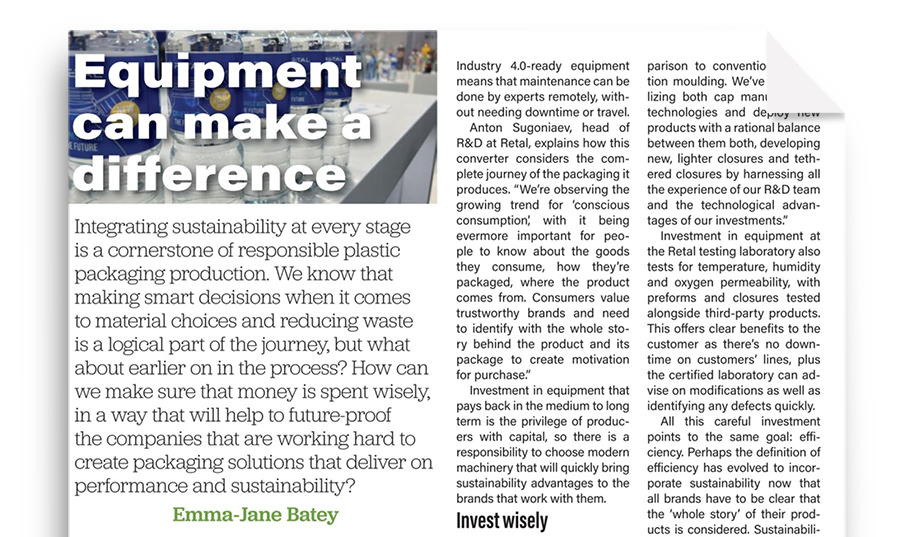
Integrating sustainability at every stage is a cornerstone of responsible plastic packaging production. We know that making smart decisions when it comes to material choices and reducing waste is a logical part of the journey, but what about earlier on in the process? How can we make sure that money is spent wisely, in a way that will help to future-proof the companies that are working hard to create packaging solutions that deliver on performance and sustainability?
Choosing the equipment that will make the right difference is not the decision of one department, nor is it a wish list of ‘nice to haves’ that will somehow revolutionize an inefficient production facility. As Posh Spice famously said, ‘It’s easy to buy a £5m house’. OK, she wasn’t talking about investing in packaging machinery (I don’t think), but the message is the same; you’ll always find someone that’s trying to sell something, but it’s your responsibility to buy the right thing at the right price.
So what is ‘the right thing’ when it comes to choosing equipment that will enable plastic packaging producers to progress sustainably? With sustainability coming from all directions, that choice needs to consider the production site, the product, and the consumer...and the environment.
It’s not about thinking that choosing to add rPET is enough, or that lightweighting preforms is enough. Yes, these are both very important steps forward, but there is more that can be done, even if the buzzwords are not quite as trendy. Equipment that uses less energy, generates less waste, or requires less water means that responsibility is integrated earlier. Industry 4.0-ready equipment means that maintenance can be done by experts remotely, without needing downtime or travel.
Anton Sugoniaev, head of R&D at RETAL, explains how this converter considers the complete journey of the packaging it produces. “We’re observing the growing trend for ‘conscious consumption’, with it being ever-more important for people to know about the goods they consume, how they’re packaged, where the product comes from. Consumers value trustworthy brands and need to identify with the whole story behind the product and its package to create motivation for purchase.”
Creating a motivation for purchase is certainly a driver for brands and the whole supply chain, with the understanding that integrated sustainability is both a want and a need. Sugoniaev defines this as ‘raising a sustainability-oriented mindset’, with the role of the plastic packaging supply chain including educating consumers in how their choices impact on the production. “If consumers understand that clear caps and bottles are more sustainable than coloured bottles in terms of recyclability, for example, or reduced label sized vs full sleeve, and their purchasing preferences are aligned accordingly, then as a society we’re heading for a more sustainable future. As a plastic packaging producer, we can help to positively influence that by promoting an honest, transparent dialogue with our brand owner customers, to see how we can bring extra elements of sustainability into our production, which can also be used in brand marketing.”
Investment in equipment that pays back in the medium to long term is the privilege of producers with capital, so there is a responsibility to choose modern machinery that will quickly bring sustainability advantages to the brands that work with them. Efficiency of production is the driver for RETAL’s ongoing investment, seen in its new PET preform systems by continuously renovating the installed base to boost the reliability and efficiency of the machines, alongside a centralized resin feeding system at its largest facility in Lithuania that reduces raw material packaging and transportation costs.
Invest wisely
Sugoniaev continues, “Investment decisions are made with efficiency and sustainability in mind; our latest CSR report highlights our progress and the importance this progress is to our global partners. For example, we’ve upgraded two more of our preform machines to handle flakes and we’ve made a significant investment in closure compression molding with several new lines. We chose these lines as they are proven to run shorter cycle times and show reduced energy consumption in comparison to conventional injection molding. We’ve been utilizing both cap manufacturing technologies and deploy new products with a rational balance between them both, developing new, lighter closures and tethered closures by harnessing all the experience of our R&D team and the technological advantages of our investments.”
Investment in equipment at the RETAL testing laboratory also tests for temperature, humidity and oxygen permeability, with preforms and closures tested alongside third-party products. Efficiency is a clear advantage, as there’s no downtime on customers’ lines, plus the certified laboratory can advise on modifications as well as identifying any defects quickly.
All this careful investment points to the same goal – efficiency. Perhaps the definition of efficiency has evolved to incorporate sustainability now that all brands have to be clear that the ‘whole story’ of their products is considered. Sustainability for its own sake is better than nothing, but when investment in efficiency is combined with understanding sustainable design, production and testing, then a more circular approach to plastic packaging is within reach.
Wrap-up
Ultrasonic welding uses around 50% less energy than conduction heat sealing systems
Pneumatic power can help stretch blow molding efficiency with higher throughput and continuous production
Smart automation reduces downtime, promotes preventative maintenance and gives clear analytics in real time
Read online at Sustainable Plastics (page 11)
Read / download in PDF